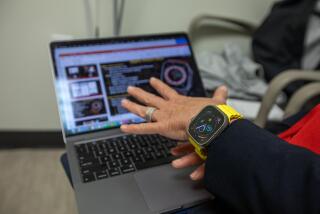Small Device Proving Its Worth on Some Heart Attacks
- Share via
An airplane cabin hundreds of miles from the nearest medical facility might seem to be one of the worst places to have a heart attack.
But for certain types of heart attacks called cardiac arrests, airplanes--and, surprisingly, casinos--may be some of the best places other than a hospital itself, according to research reported today in the New England Journal of Medicine.
The reason is a new type of technology called automated external defibrillators, computer-controlled devices that administer a shock to the heart to get it beating properly.
Two separate studies report that the devices, which can be used easily by flight attendants and security guards, increased survival rates to 40% on airplanes and 53% in casinos--or 10 times the normal rate. The defibrillators allow treatment to begin much more quickly than is possible if paramedics or other emergency personnel must be summoned.
The new findings, obtained in 32 casinos across the country and on flights operated by American Airlines, are “extremely encouraging and should give new impetus to efforts to deploy the devices,” said Dr. Rose Marie Robertson of Vanderbilt University Medical Center. Robertson is president of the American Heart Assn., which has been campaigning to have defibrillators in a wide variety of public places, including police and fire department vehicles, ambulances, nursing homes, malls, stadiums, theme parks and other busy places.
With wider use of defibrillators across the country, “it should certainly be possible for us to improve survival rates to 20% to 30%,” Robertson said.
Most U.S. airlines have installed defibrillators or are committed to doing so, said Michael Wascom, a spokesman for the Air Transport Assn. “We even have them in our office here,” he said.
The use of defibrillators got a boost with the 1998 passage of the Aviation Medical Assistance Act, which provided legal immunity to airlines, airline personnel and medically trained passengers who provide assistance to sick passengers. In May, the Federal Aviation Administration proposed that the devices be required within 36 months on any flight having a flight attendant.
Some foreign carriers also are installing the defibrillators, and the pace may be accelerated after a recent lawsuit in which Lufthansa was found liable for not providing adequate care to a passenger who had a cardiac arrest on an aircraft not equipped with the device.
What mainly concerns airlines now, Wascom said, “is that the public and our passengers would come to view airline crew members as trained emergency medical technicians when they clearly are not.”
Most large casinos have the devices in place now, according to industry spokesmen, in part because much of their clientele is elderly.
About 225,000 Americans suffer cardiac arrests each year, in which heart muscles quiver uncontrollably instead of acting together to pump blood. Only 2% to 5% of those who suffer such arrests outside a hospital survive, largely because of delays in beginning treatment.
Quick treatment with defibrillators can raise the survival rate dramatically, with an increase of about 10% in survival for every minute saved.
American Airlines began placing the devices on its aircraft in 1997. Flight personnel undergo four hours of training in their use. The four-pound devices are so simple to operate that one study showed untrained sixth-graders could use them properly, Robertson said. The device contains a built-in electrocardiograph, which determines if the patient is suffering cardiac arrest. If so, it then recommends that a shock be administered.
A team headed by Dr. Richard Page of the University of Texas Southwestern Medical Center in Dallas compiled data on the first 200 times the defibrillators were used on American’s planes. In 186 of those cases, the device showed that the patient was not, in fact, suffering cardiac arrest and no shock was administered.
Even so, the devices allowed physicians who happened to be on the flights or other personnel to monitor the patients’ health and decide whether a diversion to a nearby airport was necessary.
The other 14 people were found to be suffering a cardiac arrest and 13 were shocked; defibrillation was withheld in one case at the family’s request. Forty percent of those patients survived and were successfully discharged from the hospital. In the absence of treatment, it is likely that all would have died.
That “compares favorably” with the survival rate of patients treated rapidly on the ground by emergency personnel, Page said. But the results show the need for the devices to be installed in airports as well as on planes.
The actual number of deaths that occur on airplanes is not well documented. The International Air Transport Assn. reported only 72 deaths per year between 1977 and 1984, but other estimates go as high as 1,000 per year worldwide. A study mandated by Congress showed 108 deaths on the 15 major U.S. carriers in the 12 months ending June 20, 1999.
In the second study, Dr. Terence D. Valenzuela of the University of Arizona and his colleagues studied the first 105 patients who received an electrical shock with the device at casinos in Nevada and Mississippi.
Overall, they found that 56 of the patients (53%) survived and were discharged from hospitals. A speedy response was particularly valuable. Among those who received their first defibrillation within three minutes after they collapsed, the survival rate was 74%. If it took longer than three minutes, in contrast, the survival rate was only 49%. Even the lower figure is 10 times higher than the survival rate for cardiac arrest victims in most communities.
The average elapsed time before application of the first shock was 4.4 minutes. Paramedics did not arrive on the scene, however, until an average of 9.8 minutes had passed. Previous studies have shown that that generally would have been too late to save the victims’ lives.
Valenzuela cautioned that all of the victims suffered their heart attacks in the public areas of the casinos, where they were observed by other patrons or by security cameras. None of the attacks occurred in patrons’ rooms.
The devices cost about $3,000 apiece, but probably will get cheaper as production volume grows. “It doesn’t sound like much [money] to save someone’s life,” said Dr. Michael A. Jaker of the University of Medicine and Dentistry of New Jersey.
(BEGIN TEXT OF INFOBOX / INFOGRAPHIC)
A Cardiac Crisis Tool
Portable defibrillators, automated heart-shocking devices designed to restore a persons regular heartbeat after cardiac arrest, have proved very effective in saving lives, two studies show.
*
Sources: New England Journal of Medicine; Agilent Technologies






